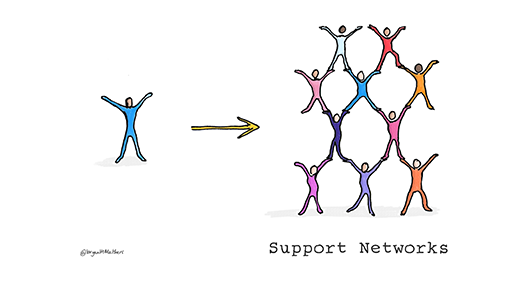Use 'Print preview' to check the number of pages and printer settings.
Print functionality varies between browsers.
Printable page generated Saturday, 22 November 2025, 10:06 AM
Session 5 Communities and networks
Introduction
One of the most effective ways to build confidence and ability in teaching and supporting learners online is to connect and talk with others. This may involve forming a network of peers who are at a similar stage and can share experiences, test ideas and offer moral support. It may involve connecting to people who have already achieved the same objective and can provide useful advice.
A great advantage of using online tools, particularly social networking tools such as Telegram, WhatsApp or Facebook, is that individuals are not limited to one physical or online place. They can decide what to discuss, how, when and with whom. Participation in these networks is sometimes described as either active or passive.
Passive participation does not involve any online engagement that is visible to others. Simply reading the comments of others without initiating or responding to a post is a form of passive engagement (sometimes referred to as ‘lurking’). ‘Active’ online learners make contributions that are obvious to others, for example, sharing resources or discussing ideas.
However, these labels may be misleading because they are based on what can be seen of a learner’s activity online. From the perspective of those online, ‘passive’ learners appear not to be engaging because they make no obvious contribution. However, they may actually be very active – reading everything, making notes, bookmarking sites, and discussing ideas with friends and colleagues. On the other hand, ‘active’ learners may appear to be working hard because their activity is visible online, but – on closer inspection – their contributions may be low quality or off topic.
Understanding concepts such as synchronous and asynchronous communication will help with online teaching. These concepts apply to a variety of platforms and tools: for example, social networking tools include discussion or message boards. They also provide ways of sharing and curating information, for example through social bookmarking and micro-blogging. Individuals can share resources and findings of their work online and can also find information and resources shared by others with similar interests.
This session covers advantages that can be gained by expanding online networks, and provides guidelines and tips for developing professional networks.
Practitioner reflections
The session starts with another video from educator Sarah. Here she reflects on her experiences with online networks. As you watch the video or read the transcript, make a note of the different ways in which Sarah uses Facebook and Twitter to support her teaching.
Transcript
How have you developed your networks?
Learning outcomes
By the end of this session, you should be able to:
- stay up to date with how digital tools are changing learning and teaching practices;
- participate in and facilitate digital teams, working groups and networks;
- collaborate effectively in digital spaces;
- participate actively in social media relevant to your professional role and interests;
- share learning and teaching materials, presentations, resources etc. on appropriate digital sites and networks;
- develop and project a positive digital identity (or identities) in your professional role and manage your digital reputation across a range of platforms.
1 Benefits of engaging with online networks

The term ‘network’ is often used in relation to computers and digital information. See, for example, this quote from an article about the value of connecting computers together to form networks:
‘Most of the benefits of networking can be divided into two generic categories: connectivity and sharing. Networks allow computers, and hence their users, to be connected together. They also allow for the easy sharing of information and resources, and cooperation between the devices in other ways. Since modern business depends so much on the intelligent flow and management of information, this tells you a lot about why networking is so valuable.’
With just a few amendments, this quote can describe the benefits of social networking to any educator:
Most of the benefits of networking can be divided into two generic categories: connectivity and sharing. Networks allow educators to be connected together. They also allow for the easy sharing of information and resources, and cooperation between the educators in other ways. Since online education depends so much on the intelligent flow and management of information, this tells you a lot about why networking is so valuable.
As described in previous sessions, online education requires thought and planning. There is also perhaps a little risk in trying new technologies and techniques. You and your colleagues may feel nervous about designing or delivering a course online, but remember that you are not alone. Reaching out to networks of people who are either in a similar position or have already done what you are starting to do can provide support and reassurance
People have different expectations about what networking is and what they are using it for. Networking can be largely invisible to others and only partly visible to the direct participants in any exchange. This is true whether networking occurs face to face or online. It is not always clear whether a person is actively networking or just having a chat. Often one becomes the other without anyone formally recognising it. Networking can be formal – introducing yourself to a group at a face-to-face conference or posting in an online discussion forum, for example. Networking can also occur much less formally, for example by following relevant Twitter accounts, or by chatting to colleagues or peers, whether face to face or via social media such as WhatsApp or Facebook.
There are several benefits to participating in networking activities and these will be discussed in the following section.
1.1 Sharing ideas and resources

Educators and those supporting or leading learning can use social networks to share ideas, tips and tricks, or resources with others in a similar position. They can join an online network and simply observe without contributing, or they might comment on other people’s ideas, and use them for their own inspiration. They can also share their ideas with others and obtain valuable feedback that improves their work.
When considering partnerships, networks and communities, it is wise to be aware of potential ‘boundaries’. These may include perspectives and power relations between different types of people, different roles, even different pay grades (MacGillivray, 2017). These distinctions will not necessarily limit the types of contribution that any individual makes, however, it is often worth observing a network to understand how it works before participating actively.
When you have established a ‘presence’ in a network, you are likely to find your relationships with certain individuals are of particular value. You may start to ask specific people for advice or find you are commenting more freely on their materials. These interactions can be channelled into the formation of a community of practice (this will be explored further in Section 2 of this session).
You can also use social networks to make connections with peers who are more experienced. Do not be afraid to reach out to those who may have more experience to ask for advice on how best to approach an element of online education. If someone reaches out to you for guidance, return the favour.
1.2 Professional development
While social networking can be informal and outside the regular work environment, its value to staff professional development can be considerable (Davis, 2011). By sharing with peers and experts via networks, people can advance their online skillsets more rapidly than they would do alone. They can also solve problems or deal with issues by asking for assistance from their networks. In addition, beyond the subject matter of online education, simply developing the skill of effective networking is a part of professional development. Many educational institutions now actively support their staff to develop social networks and recognise the value of doing this.
Activity 5.1 Social networking tools
- Make a list of what you think are the key benefits of and challenges to using social networks to support your professional development. While you are doing this, reflect on any previous experience you might have of using social networks and whether the challenges are different now to a year or two ago.
- Select two benefits and two challenges and post them on your course community of practice Facebook group. When sharing your thoughts, you could explain why you consider these important benefits and challenges. If you have not joined the community of practice Facebook group, you could discuss these ideas with colleagues within your university.
- Revisit the page later to view or comment on new posts. Are your views similar to or different from those of others?
Comment
This activity is designed to help you to think about the use of social networking tools in your context. There are many benefits, although – as you’ve probably identified yourself and discovered from your Facebook discussions – there are also challenges that need to be considered.
1.3 Making contacts
Social networking can remove many of the barriers to engaging in dialogue with the leading people in a field. A couple of decades ago it would be difficult to interact with a particular expert unless you were attending the same event. Now social and professional networks such as Twitter, LinkedIn and ResearchGate can be used to ask an expert a question. Social networking has made the education world much more accessible to its members than it has ever been before (Davis, 2011).
Activity 5.2 Identifying your existing roles in networks
Complete the following table. Which of the following networks do you already participate in? In each case, consider the type of participation you have with each network. (Participation described as ‘informal’ can take place as needed, on any topic, sometimes unrelated to your own practice; participation described as ‘formal’ would be focused on improving your practice or sharing resources.)
Type of participation > Type of network | Observer (reading other people’s input but not contributing directly) | Responder (answering questions or commenting on discussions) | Text contributor (posting questions or starting discussions) | Information contributor (providing factual information that is not your own material) | Sharer (contributing your own material for discussion or reuse) |
|---|---|---|---|---|---|
| Highlighted Informal online contact with people in your organisation that you interact with mostly face to face. | |||||
Informal online contact with people in your organisation that you interact with mostly online. | |||||
Informal online contact with people in other organisations that you have met face to face at some time. | |||||
Informal online contact with people who have come together informally via social media. | |||||
Formal online contact with people of the same subject discipline or age group. | |||||
Formal online contact with people of many backgrounds focused on particular teaching topics (e.g. flipped classrooms, online teaching etc.) | |||||
Formal online contact with other members of educational or related organisations (e.g. members of professional bodies, unions etc.) | |||||
Formal or informal online contact with other members of this course |
Comment
When planning for online education it is important to consider not only your learning materials, but also your own practice as a member of the wider education community. This activity should help you to identify where you could make the most of your existing connections and how you might make new ones online.
2 Communities

When groups of people come together online around a particular topic or job role, they are often referred to as communities. Communities are more bounded than networks. There is usually some restriction on membership and, as a result, a greater degree of trust between members. For example, to be part of a community of physics lecturers, you would need to be employed in that role or to have worked in that role. You would be more likely to trust the views of a member of that community on physics and related subjects than a member of the general public.
Communities can be central to helping to develop an approach to online education. For example, educators can seek guidance from their teaching community about how to design an online activity or find out who the experts are in a specific field of practice. Whatever your reason for seeking contact with others in the field, participating in a relevant community can be of great value, and it can lead to personal skills development, exchanging knowledge and developing practice.
2.1 Communities of practice
Communities come in many forms. When the concept of ‘communities of practice’ was discussed in Session 3, it was noted that communities can develop wherever a common interest exists between individuals, such as a shared profession:
‘Communities of practice are groups of people who share a concern or a passion for something they do and learn how to do it better as they interact regularly. Note that this definition allows for, but does not assume, intentionality: learning can be the reason the community comes together or an incidental outcome of members’ interactions.’
The Wenger-Trayners, who are leaders in this area, suggest there are three key characteristics of a community of practice:
- A shared domain of interest. A community of practice is not just a group of friends; membership implies a commitment to the domain, and therefore a shared competence that distinguishes members from other people.
- An active community, sharing and exploring the domain. Members engage in joint activities and discussions, help each other and share information. They build relationships that enable them to learn from each other and they care about their standing with each other. However, they do not necessarily work together on a daily basis.
- An impact on the practice of those involved. Members of a community of practice are practitioners. They develop a shared set of resources: experiences, stories, tools, ways of addressing recurring problems – in short, a shared practice. This takes time and sustained interaction.
The Wenger-Trayners state that ‘it is the combination of these three elements that constitutes a community of practice, and it is by developing these three elements in parallel that one cultivates such a community’. Networks can develop into communities of practice but will usually require sustained effort and contributions to persist.
Activity 5.3 Your communities of practice
Think about the range of social and professional communities you belong to. Reflect on why they work so well (and if they do not work well, why not). Is there a difference between a ‘network’ and a ‘community’? Are these inclusive communities?
Share your reflections about the value you get from belonging to these communities with others in the course via the course community of practice Facebook group. Read the contributions of others and note any suggestions they have made that you could benefit from in the future. If you have not joined the community of practice Facebook group, you could discuss your reflections with colleagues at your university.
Comment
This activity is intended to help you reflect on the way communities you belong to operate and how they support those who belong to them.
3 Developing communities of practice
You may be looking for a wider community, wanting to find out about best practice, interested in the latest developments, or seeking to help others by sharing successful techniques and technologies. In all these cases you are likely to find it valuable to connect with like-minded people by expanding your networks and joining (or helping establish) one or more communities of practice.

One way of expanding work-related networks is to join an established community of practice (Krutka et al., 2014). This can be done by:
- searching the internet for communities related to your work;
- joining one or more of these communities, observing the discussions that take place, and deciding whether you would benefit from taking a more active role;
- choosing one or two of these communities for more active participation and using these to establish/develop your professional identity, skills and a sense of membership.
For those working in education, there are several services that offer ways to find and connect with others. One of the most widely used is the professional networking site LinkedIn, which provides for all kinds of professionals and claims to be ‘the world’s largest professional network on the Internet’ (LinkedIn, 2020). For those working in higher education, more specialised social-networking services are available, such as Academia and ResearchGate, which help academics and researchers engage with each other through sharing publications and facilitating communication.
3.1 Microblogging
A useful way to make contact with like-minded people is to use a microblogging site such as Twitter (Carpenter & Krutka, 2014) or Tumblr. However, millions of posts are made every day to microblogging sites, so it is important to think about how you want to engage and manage your interactions. You may find the following actions useful:
- Gather information on a particular subject. Make a list of keywords or hashtags to search for. Hashtags may be long or short. They start with the hash symbol (#) and can include phrases and acronyms, but without spaces, for example #DigitalUniversity or #OpenLearn.
- Follow and learn from experts in a particular subject. List the names of the experts to search for.
- Look at the profiles of experts to see who they follow. A lot of the people they follow are likely to be of interest to you.
- Make connections with people in a similar position to yourself. Think of ideas about how you might find those people – how will you search for them? You may need to combine some keywords or hashtags into a single search, enabling you to filter out information that is related, but not precisely what you are looking for.
- Share your own work. Identify precisely which items you would like to share, list some keywords and hashtags that might describe your work, and practise creating a short microblogging message that describes your work succinctly.
Services such as Twitter are relatively easy to use. The instructions below will help you to maximise the benefits of Twitter. If you use a different tool the same principles apply, but you will need to alter the method and tools to suit your platform.
- Create an account on Twitter.
- Use your Twitter account to register with TweetDeck. TweetDeck is a very good way to make sense of the vast amount of information on Twitter and helps you to arrange the information you need in easily managed columns.
- Use the search function in TweetDeck to generate new columns relating to your keywords or hashtags of interest, or search for experts and follow them – all tweets from accounts that you follow will appear in your Home column in TweetDeck in chronological order.
- If you are looking for peers, first find and follow likely people – they may well follow you back (it is good Twitter etiquette to follow individuals who follow you). When you are familiar with each other’s tweets, you could suggest forming a List (a column in your TweetDeck that gathers tweets from selected individuals which others can subscribe to).
- If you want to share your own work, learn from how others do it. Observe how they use their tweets, how they ask for feedback or for others to retweet them. Aim to build a good number of followers before sharing your work so that their retweets will increase your reach.
Activity 5.4 Sharing information
Think again about the professional networks and communities you already belong to (formal and informal) and consider how these communities share information. What tools do they use? How do you decide which information can be trusted?
Pick one example. How could they use other channels or social media to improve the flow of information?
Now think about the community of practice that is forming around this course. What could you do to maximise the benefits for you and for other members?
Comment
This activity helps you to develop as a networked individual. It should help you to identify how you could make use of the networks and communities available to you to inform and improve your online practice. When you have completed this course these connections will enable you to keep developing your practice.
4 This session’s quiz
Check what you have learned this session by taking the end-of-session quiz.
Open the quiz in a new window or tab, then return to this session when you’re done.
Summary
This session has presented a variety of possible paths to become a more networked professional. It has highlighted the benefits of being connected to others with similar interests or areas of practice. Hopefully you now have some ideas about where you want your networking to go next – Rita has certainly got a few ideas!
Activity 5.5 Reflecting on progress
Watch the video or read the transcript. In it, Rita reflects on Session 5 from her perspective as an educator. Take some time to make notes on the following questions:
- How does what you have learned in this session relate to your own role?
- What changes, if any, could you make to your practice or to the wider practice at your university as a result of what you have learned?
Transcript
You can now go to Session 6.
